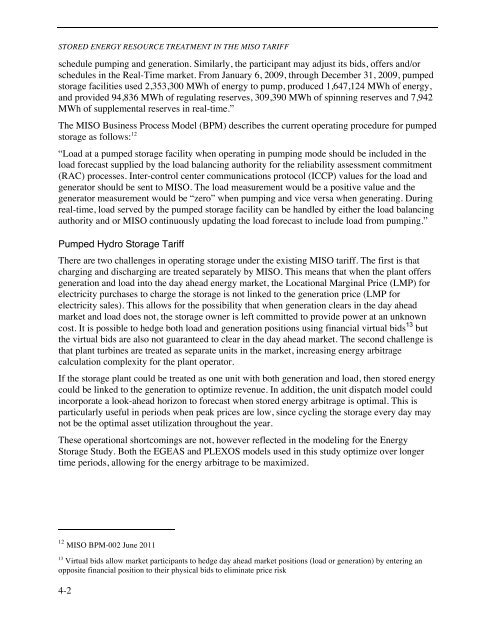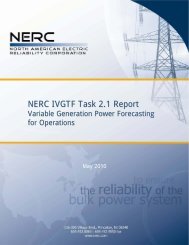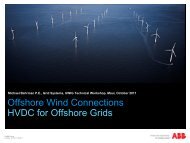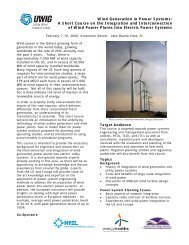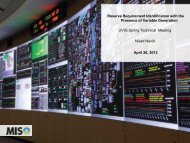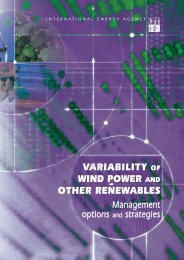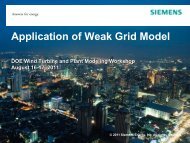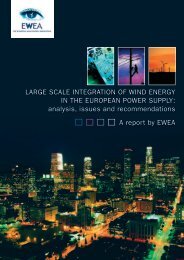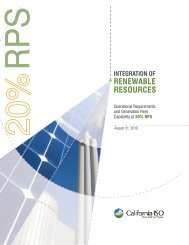MISO Energy Storage Study Phase 1 Report - Utility Wind ...
MISO Energy Storage Study Phase 1 Report - Utility Wind ...
MISO Energy Storage Study Phase 1 Report - Utility Wind ...
You also want an ePaper? Increase the reach of your titles
YUMPU automatically turns print PDFs into web optimized ePapers that Google loves.
STORED ENERGY RESOURCE TREATMENT IN THE <strong>MISO</strong> TARIFF<br />
schedule pumping and generation. Similarly, the participant may adjust its bids, offers and/or<br />
schedules in the Real-Time market. From January 6, 2009, through December 31, 2009, pumped<br />
storage facilities used 2,353,300 MWh of energy to pump, produced 1,647,124 MWh of energy,<br />
and provided 94,836 MWh of regulating reserves, 309,390 MWh of spinning reserves and 7,942<br />
MWh of supplemental reserves in real-time.”<br />
The <strong>MISO</strong> Business Process Model (BPM) describes the current operating procedure for pumped<br />
storage as follows: 12<br />
“Load at a pumped storage facility when operating in pumping mode should be included in the<br />
load forecast supplied by the load balancing authority for the reliability assessment commitment<br />
(RAC) processes. Inter-control center communications protocol (ICCP) values for the load and<br />
generator should be sent to <strong>MISO</strong>. The load measurement would be a positive value and the<br />
generator measurement would be “zero” when pumping and vice versa when generating. During<br />
real-time, load served by the pumped storage facility can be handled by either the load balancing<br />
authority and or <strong>MISO</strong> continuously updating the load forecast to include load from pumping.”<br />
Pumped Hydro <strong>Storage</strong> Tariff<br />
There are two challenges in operating storage under the existing <strong>MISO</strong> tariff. The first is that<br />
charging and discharging are treated separately by <strong>MISO</strong>. This means that when the plant offers<br />
generation and load into the day ahead energy market, the Locational Marginal Price (LMP) for<br />
electricity purchases to charge the storage is not linked to the generation price (LMP for<br />
electricity sales). This allows for the possibility that when generation clears in the day ahead<br />
market and load does not, the storage owner is left committed to provide power at an unknown<br />
cost. It is possible to hedge both load and generation positions using financial virtual bids 13 but<br />
the virtual bids are also not guaranteed to clear in the day ahead market. The second challenge is<br />
that plant turbines are treated as separate units in the market, increasing energy arbitrage<br />
calculation complexity for the plant operator.<br />
If the storage plant could be treated as one unit with both generation and load, then stored energy<br />
could be linked to the generation to optimize revenue. In addition, the unit dispatch model could<br />
incorporate a look-ahead horizon to forecast when stored energy arbitrage is optimal. This is<br />
particularly useful in periods when peak prices are low, since cycling the storage every day may<br />
not be the optimal asset utilization throughout the year.<br />
These operational shortcomings are not, however reflected in the modeling for the <strong>Energy</strong><br />
<strong>Storage</strong> <strong>Study</strong>. Both the EGEAS and PLEXOS models used in this study optimize over longer<br />
time periods, allowing for the energy arbitrage to be maximized.<br />
12 <strong>MISO</strong> BPM-002 June 2011<br />
13 Virtual bids allow market participants to hedge day ahead market positions (load or generation) by entering an<br />
opposite financial position to their physical bids to eliminate price risk<br />
4-2


